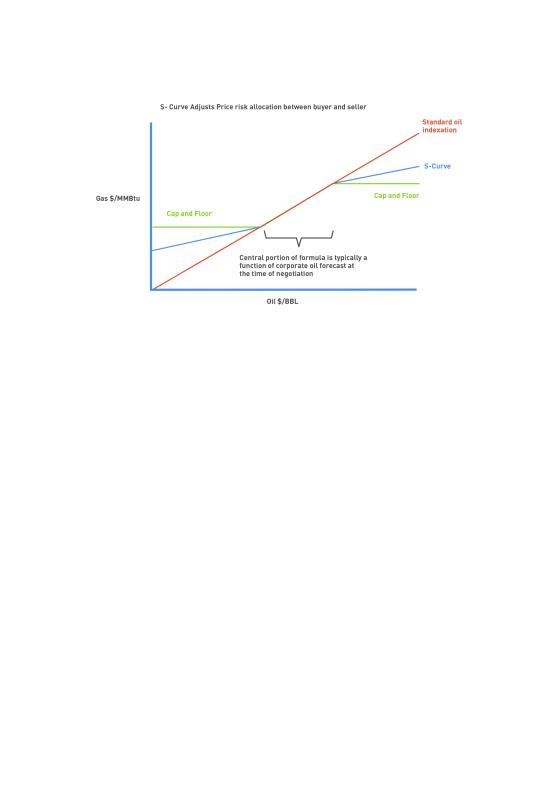
01 POWER ISLAND / 01 CCPP / DOE__Understanding Natural Gas and Lng Options October 11 2017_1
.pdf
PRICING
Costs, Insurance and Freight (CIF) Pricing: is a hybrid, which contemplates that the buyer takes title and risk of the LNG at the liquefaction facility but
the seller pays for transportation from the liquefaction facility to the destination market. The significance of the delivery point is that costs are shifted between the seller and buyer.
The calculation of marine transportation and regasification costs are specific to the ship and receiving terminal to be used.
The destination market pricing is specific to the destination market. For example, U.S. netbacks come from an average of the closing price taken from the New York Mercantile Exchange (NYMEX) on the 3 trading days before and including the date reported for delivery at
Henry Hub. A local adjustment may be required for pipeline transportation costs depending on the location of the LNG receiving
terminal. The calculation of United Kingdom netbacks comes from an average of the closing price on the Intercontinental Exchange (ICE) futures contract for delivery at National Balancing Point (NBP). Japanese netbacks are derived from the official average ex ship prices for the most recent month. A World Gas Intelligence European Border Price table is used to estimate the most recent ex ship prices for Spanish market netbacks.
136

PRICING
Price Review or Price Re-openers
As previously discussed, unlike crude oil, LNG is not yet priced on an international market basis and most LNG is priced on a long-term basis of 20 years or more. The contractual and confidential nature of LNG pricing, coupled with a lack of transparency of individual cargo prices, means that a wide range of prices might exist even within the same country or region. For example, an LNG contract entered into many years ago may still be in effect under far different pricing structures than those that existed at the time it was first agreed.
Historically, some Asian buyers have been able to introduce price caps or “S-curves” into their pricing mechanisms, which protect them against very high oil prices and in return, protect sellers against very low oil prices.
An S-curve is so-called because the relationship between the oil price and the gas price is altered to give the seller relief in a low oil price market (a higher price than would apply from strictly applying the oil index - 14% JCC as an example), and to give the buyer relief in a high oil price market (a lower price than the oil index would generate). Thus in a plot of gas price against oil price, the start and end of the line has a flatter slope than the middle and the resulting line has an S-shape which gives rise to the name. Sometimes, the S-curve approach can be used to derive a price floor at low oil prices, and a price ceiling at high oil prices. The graphic below illustrates a generalized S-curve.
137

PRICING
In addition, a price review or price “re-opener” clause is found in many longterm contracts. An example of the language typically used is as follows:
"If . . . economic circumstances in the [buyer’s market] . . . have substantially changed as compared to that expected when entering into the contract for reasons beyond the parties’ control . . . and the contract price . . . does not reflect the value of natural gas in the [buyer’s market] . . . [then the parties
may meet to discuss the pricing structure]" (Susan Sakmar "Energy for the 21st Century").
Price review clauses have been a feature of continental European long-term pipeline gas sale contracts for a long time. Lawyers from other regions and legal traditions are often uncomfortable with such clauses because when they are invoked, the parties usually find that their interests are more divergent than expected.
Nonetheless, price review or reopener clauses still remain a key clause of most long-term LNG SPAs and many, if not all, LNG suppliers and buyers enter into negotiations without fully grasping how difficult it is to negotiate such clauses, especially if they are to be enforceable if invoked. As such, the following are key elements that must be addressed with negotiating a price reopener clause:
138

PRICING
>The trigger event or conditions entitling a party to invoke the clause must be defined. Usually, this is a change of circumstances beyond the control of the parties.
>The elements of the price mechanism which are subject to review must be defined and usually include:
•The base price
•Indexation
•Floor price
•Ceiling price
•Inflection points of the S-curve formula
If a requesting party has satisfied the trigger event or criterion, then there is the challenge of determining which benchmark should be applied to determine the revised price mechanism and often the buyer’s and seller’s view of the relevant market differ significantly. Moreover, since the LNG market is still mostly long-term negotiated contracts that are not public and transparent, the parties may not always be able to access the information and data needed in relation to the broader market for the price-reopener negotiations.
If the parties cannot agree on a revised price mechanism, then the parties should consider referral of the matter to a third-party or arbitration. However, many LNG contracts contain “meet and discuss” price review clauses that do not allow for such referral, leaving the parties without recourse unless some specific recourse is specified. For example, the parties could provide that if the parties are unable to agree on the revised price mechanism, then the seller has the right, upon written notice, to terminate the long-term LNG SPA.
139

PRICING
Recent Pricing Issues
Given the volatility and significant variations in regional gas pricing over the last few years, both LNG sellers and LNG buyers are becoming increasingly focused on how to develop gas pricing mechanisms that give sellers a revenue that reflects the global value of their product, in a manner that will support project development. These pricing mechanisms also provide buyers with a market clearing price, which will enable them to supply gas to their customers at a competitive rate.
With the increasing power of buyers in the currently over-supplied market, new pricing mechanisms are emerging, which give the buyer a choice or mix of pricing indices. This new flexibility is sometimes coupled with short-term volume and destination flexibility, with the ability to turn back cargoes that are priced at what the buyer may consider an uncompetitive level.
These increasingly complex price-and-volume provisions are leading sellers to more complex hedging and risk management strategies. New pricing provisions are also supporting the LNG aggregator business model, where an intermediary, either an IOC or an LNG trading entity, takes on the role of accommodating both buyer and seller pricing concerns and manages a portfolio of gas sources and destinations in order to appropriately manage risk.
LNG pricing formulas are evolving at the moment from pure oil-linked pricing to pure gas-linked pricing, although the full evolutionary process is still underway. As a result, there are various mixed pricing formulas in use at the moment, including pricing techniques that modulate fluctuations in oil pricing, such as an "S" curve which bends the percentage of a crude price at extreme highs and lows.
140

PRICING
Another consideration in pricing is the emergence of 'pricing review' clauses in LNG SPAs, where the LNG price can be examined and changed at periodic intervals if specified market conditions are triggered. While the intent of these clauses is to preserve a link between a long-term contract and the actual market pricing, such clauses can be very contentious and lead to disputes between sellers and buyers.
141

LNG and Gas
Contracts
Introduction
Upstream Contractual Structures
Preliminary Agreements
Domestic Gas Sales Agreement
LNG Sale and Purchase Agreement
Miscellaneous Agreements

LNG AND GAS CONTRACTS
Introduction
Gas projects require different types of contracts at different stages of the project development, from upstream to midstream through to downstream. While a significant amount of these contracts are negotiated between private parties, some of the most important ones involve host governments. The ability of governments of resource-rich countries to effectively steward the exploitation of natural resource wealth is predicated upon a number of factors. One of these is the ability to represent the interests of current and future generations in negotiations with private investors and regional partners involved in cross-border natural resources projects.
In that context, an understanding of the different types of contracts, their place in the value chain, and the development of the project, are important. Particular attention should be paid to the technicality and complexity of these contracts. The objective is that governments can prepare effectively for these negotiations, build necessary knowledge to make informed decisions and create dedicated negotiations teams. In addition, contract implementation is equally important and host governments should also build capacity and dedicate resources.
This section aims at providing an overview of the different types and categories of contracts in order to enable governments to prepare accordingly.
143

LNG AND GAS CONTRACTS
PSC v. Licenses
The way in which the upstream contractual arrangements are configured is a complex matter, the basics of which are summarized as follows.
The four contractual structures that have been adopted comprise:
>Production sharing contracts
>Licenses/ Concessions
>Joint ventures
>Service contracts
Typically a PSC would involve lower risk for the investor in that costs are sometimes recovered in a more timely and efficient manner. However, the mechanisms can be complex and entail longer-term risks and cost recovery in economics. In upstream environments that are more stable and sustainable, concessions may offer a better long-term balance.
In the context of LNG projects, the upstream contractual arrangements are not a primary determining factor and have been developed around the world using both primary types of arrangements. Examples of LNG projects under licenses can be found in Qatar, Australia, and the U.S. LNG projects under a PSC/PSA can be found in Indonesia, Malaysia, and Angola. Nigerian LNG projects are based on upstream joint venture arrangements.
Regardless of the upstream structure selected, other legislation (laws), regulations and/or contracts will likely be required for liquefaction and new large-scale natural gas development since many pre-existing host government contracts do not address the specifics of natural gas development. Some of these other contracts are discussed below in the miscellaneous agreements section.
144

LNG AND GAS CONTRACTS
Preliminary Agreements
The negotiation process for the LNG sale and purchase agreement (SPA) can often be quite lengthy and detailed. Given the multi-year timeframe, it is often necessary to demonstrate progress in the negotiating process. Some sort of preliminary document between the parties is therefore often desired to build confidence in the project and, perhaps, document acceptance of specific terms for the government or the investors' management.
Preliminary documents can include:
>Term Sheet
>Letter of Intent (LOI)
>Memorandum of Understanding (MOU)
>Heads of Agreement (HOA)
These documents are listed in their progression of detail and completeness, with an HOA typically representing one step below a full definitive agreement, such as an SPA.
The key issue in all preliminary documents is whether the parties involved are legally bound by the provisions of the preliminary document or whether the parties are still free to negotiate other or different terms, and this may often be a complex matter on which legal counsel would advise. For example, local law may treat some or all of a preliminary document as legally binding even where the preliminary document states otherwise.
Even if a preliminary document is clearly not legally binding, it can lead to disputes if one party later deviates from the provisions of the preliminary document.
145
